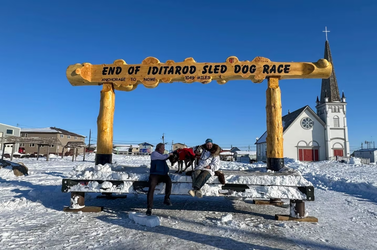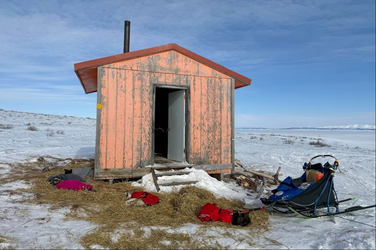
Quince Mountain sits under the burled arch after mushing to Nome. (Courtesy of John Handeland)
Iditarod rookie Quince Mountain was at the back of the pack.
It was Wednesday, March 12, just about 10 days since Mountain and the other mushers in this year’s extra-long Iditarod Trail Sled Dog Race pulled their snow hooks in from the river ice in Fairbanks. The front of the pack was hundreds of miles away, racing across the coast of the Seward Peninsula. Mountain was in his second pass through Grayling along a loop through around the Lower Yukon, 659 miles into this year’s extended route, with another 469 miles to go to Nome. And that’s where Mountain was told that he and another rookie, Sydnie Bahl, were being cut.
“While Mountain wished to continue the race, the decision was made based on rule 36 of the official Iditarod race,” the Iditarod Trail Committee said in a statement at the time. “Rule 36 states: Competitiveness: A team may be withdrawn that is out of the competition and is not in a position to make a valid effort to compete. The Race Marshal may consider, but is not limited to, weather, trail conditions and the overall pace of the Race when invoking this rule.”
This had already happened to Mountain once before. In 2020, during his first Iditarod attempt, he was withdrawn under Rule 36 at the Unalakleet checkpoint.
This time, though, instead of going home, Mountain eventually slimmed down his dog team and kept going toward the finish line.
“I wasn’t in the race anymore, so I could do what I wanted,” Mountain said by phone in an interview.
He ultimately arrived on March 19, 5 1/2 days after this year’s winner, Jessie Holmes, had crossed under the Burled Arch, and about 2 1/2 days later than the Red Lantern.

Two of Quince Mountain’s lead dogs, Pepe and Whip, in the Topkok Hills along the Norton Sound coast on their way to Nome in March. (Courtesy of Quince Mountain)
‘I really took my sweet time’
Mountain didn’t mush the whole race course between Grayling and Nome. After he was withdrawn, race officials flew him and his 10-dog team to the community of Unalakleet, 227 trail miles away. The town serves as a logistics and transportation hub for Iditarod, and the plan was that from there, Mountain and his dogs could more easily get back to the road system.But the 42-year-old Wisconsinite had business he needed to handle first: He’d intended to scatter the ashes of a friend along the trail as it passes through the Blueberry Hills north of Unalakleet. Initially, his plan was to go up to a shelter cabin in the area, then back to town.
“I thought, ‘Maybe I’ll go further if the dogs look good and are happy,‘” Mountain said.
Continuing wasn’t a totally cavalier, spur-of-the-moment decision. But it was also far from a given. Few mushers return to their sleds after their Iditarod is ended, be it from scratching of their own volition or under Rule 36.
But even prior to Mountain, there were exceptions.
In 1989, 81-year-old Norman Vaughan was axed but mushed along on his own until he arrived in Nome on April 1, six days behind the Red Lantern. In 1995, Tim Triumph was cut in Unalakleet but continued mushing, and later successfully appealed the race’s decision. Going in the other direction: In 2020, as the spreading COVID-19 pandemic was shutting down much of the U.S., musher Jeremy Keller scratched in the town of Nikolai and then mushed his team back over the Alaska Range to his home in Knik.
Mountain was clear-eyed that if he kept going up the trail for another 262 miles to Nome, he would be doing so without the logistical support of the Iditarod: no veterinarians, no drop bags with supplies at checkpoints, no tracker device with an SOS button to push in case of an emergency. But he also knew the area was well-traveled by snowmachiners, and coordinated with a friend who would be able to get to him in a few hours if things went south. He pared down his team to six experienced dogs, loaded more than a hundred pounds of meat into a slimmed-down sled, and set out.
In a short video stitched together from clips Mountain shot during the journey, he gently pours out some of the cremated remains of his friend, Alaska resident Daniel Lent, who was a fan of the Iditarod and had volunteered with the event before passing in 2023.
“You left this earth too soon, but this is a good spot for you. And you’ll be missed,” Mountain can be heard saying, his dogs resting on snow in the dark woods.
Without a race to worry about, Mountain said he got to really enjoy traveling along the trail. He did things that are prohibited during Iditarod competition: He brought his dogs into a shelter cabin for a long rest, stopped to help a snowmachiner, let a resident in a community where he stopped dish out a meal to his team.
“It was like the camping trip everybody talks about at the back of the pack,” Mountain said. “When I was in the race, I was not on a camping trip … but once I was out of the race I was on a camping trip, and it was lovely.”
He left Unalakleet that Friday evening, March 14, and was on the trail for close to another five days.
“I really took my sweet time getting to Nome,” Mountain said.

A small shelter cabin along the trail north of the community of Shaktoolik. Quince Mountain stopped at some of the public cabins along the way from Unalakleet to Nome, and ran mostly unsupported after he was withdrawn from the race. (Courtesy of Quince Mountain)
To his surprise, when Mountain came off of the sea ice into town on the afternoon of March 19, he was greeted by a police escort to Anvil City Square, the middle area of town by Old St. Joe’s Church where the burled arch stands for most of the year in between Iditarods. His sled ran over bare ground down Front Street, the ribbon of snow leading to the finish line having been cleared away when Iditarod festivities ended after the musher’s banquet a few days prior. There were tourists and a few Nome residents on hand who cheered for him, even though the official Iditarod was over.
“It was such a Nome welcome, and it was so sweet,” he said. “It just feels like celebratory and good, and like a part of something.”
‘On my own terms’
When Iditarod organizers pulled Mountain and Bahl from the race, there was an outcry online.“This is one of the dirtiest tricks ever pulled by the Iditarod,” race veteran Vern Halter wrote in a widely circulated Facebook post the day the withdrawals were announced. “Something is seriously wrong with the Iditarod mentality of not helping and encouraging finishers — no matter where they are or in what position ... This is an absolute travesty.”
The thrust of many comments made on social media was that the two rookies were not especially far behind the front of the pack, particularly given this year’s slow conditions and expanded race route — elongated by an extra 130 miles as part of shifting the restart north to Fairbanks.
Mountain also has a robust online following. He and his wife’s kennel in northern Wisconsin, BraverMountain Mushing, has supporters around the country and globe, many of whom are organized into a loose confederation that call themselves the “Ugly Dogs.” Since 2019, many of those supporters have been behind the “Igivearod,” which describes itself as a “volunteer-directed fundraising drive that runs alongside races in Alaska.” In its first year, the effort brought in $110,000, most of which was disbursed to schools in rural Alaska.
The causes funded by the Igivearod have expanded to include not just schools, but also programs for rural veterinary care, aid for abused women, queer rights organizations and more. This year, it raised close to $139,000 from small individual donations, according to a spreadsheet from organizers.
A spokesperson for the Iditarod Trail Committee did not return messages requesting an interview on whether Mountain’s trip to Nome changed any considerations about how Rule 36 was applied in this year’s race. But last week, ITC released a statement about the provision.
“While we strive to maintain flexibility in regards to Rule 36, we must also recognize that the race itself is a high-level competition with inherent standards of excellence,” ITC wrote in its statement. “While we offer as much support as possible when a team lags far behind the leaders, and is no longer reasonably competitive then we carefully assess the dynamic. Taking into account the musher’s individual situation and the trail, weather, pace of the race and the well-being of their dogs or combination thereof, there is a threshold that necessitates making the difficult decision to withdraw a team from the race.”
Mountain said he had no hard feelings against Iditarod officials for pulling him out.
“I actually don’t begrudge the race,” Mountain said, adding that he understands there is a finite amount of personnel and resources to handle mushers, checkpoints and volunteers stretched out over hundreds of miles of rugged terrain.
But he was also clear that it was not his decision to stop mushing in this year’s race. Part of that, he said, was because there were so many people who’d supported him, donated to his effort or chipped in one way or another, and he did not want them to think that he’d given up and quit.
“They had sort of encouraged me,” Mountain said.

Quince Mountain mushes down Front Street in Nome. (Courtesy of John Handeland)
Going from the experience of being largely alone with his dogs for days in the wilderness, sleeping with them on the ground, eating alongside them, then suddenly being pulled off the trail, Mountain said, was “very jarring, at a minimum.”
The unsupported junket up the coast from Unalakleet went well. There was no extreme weather or major accidents. Toward the end of his short video, Mountain walks up and down the gang-line hugging his dogs and weeping as thanks them for going all the way.
“I felt like I ended with my team, on my own terms,” Mountain said.
source: https://www.adn.com/outdoors-advent...-being-too-far-behind-he-went-to-nome-anyway/
archive: https://archive.md/30Lgg